This blackcurrant cake is a fantastic upside-down cake to try out. It’s full of enticing flavours including sweet pistachio nuts, tropical coconut and creamy vanilla. The juicy fruit is the crowning glory in this easy to make blackcurrant recipe.
Try a glass of blackcurrant cordial with your cake.
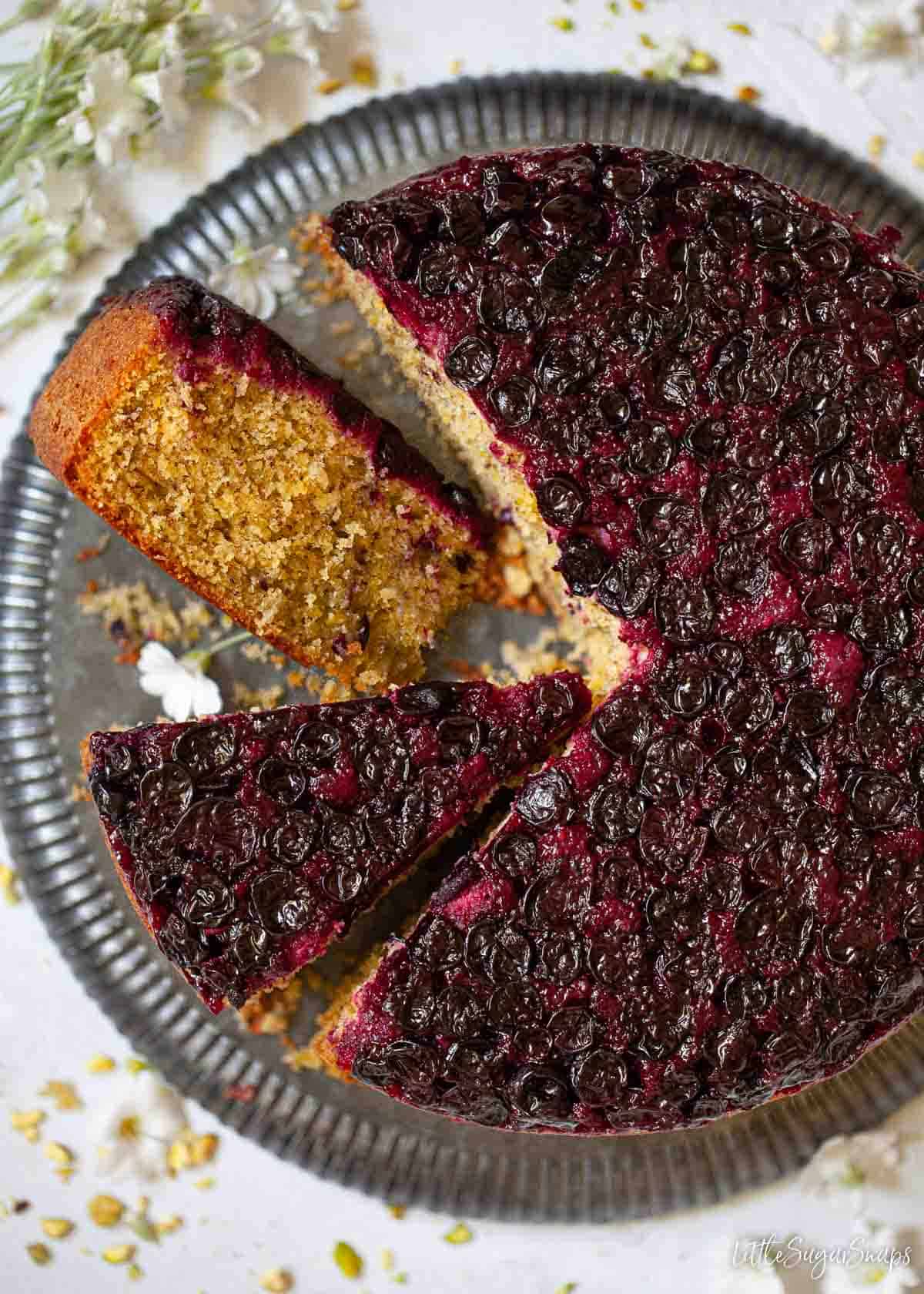
Want to Save This Recipe?
Jump to:
Why you’ll love this blackcurrant recipe
- Flavour-packed: Pistachios, coconut, and vanilla add depth and a subtle twist to this blackcurrant sponge cake.
- Great texture: More bite and richness than a standard sponge cake.
- Fruit-forward: Tart blackcurrants shine and perfectly balance the sweet sponge.
- Stays fresh: Keeps well for up to 5 days.
- Freezer-friendly: Can be made ahead and frozen.
Can’t get enough blackcurrant recipes in your life? You’re in luck — I have plenty of enticing blackcurrant recipes. From fruity favourites like blackcurrant ice cream, blackcurrant sorbet, apple and blackcurrant crumble, to showstoppers like blackcurrant cheesecake and blackcurrant pies. You’ll also find a refreshing blackcurrant smoothie and even a luscious blackcurrant cocktail.
What are blackcurrants?
Blackcurrants are small, dark berries with soft, juicy flesh and a bold, tangy flavour. They are usually too tart to eat raw, they’re perfect to use for jams, syrups and bakes such as this blackcurrant cake.
Where do blackcurrants grow?
Blackcurrants are native to Northern European countries and Asia.
While once farmed in the US, they were banned in the early 1900s due to concerns about their impact on the logging industry. Although no longer considered a threat, the ban’s legacy lingers, making blackcurrants hard to find in many US states today.
Blackcurrant or black currant?
Whether you say blackcurrant or black currant depends on where you’re from.
Here in the UK, we typically refer to blackcurrants. However, in America, it is more common to see black currants written as two words.
Are blackcurrants healthy?
Blackcurrants do come with a range of associated health benefits.
However, many blackcurrant recipes (including this irresistible upside-down cake!) also include generous amounts of sugar and butter. So while the berries themselves are full of goodness, I can’t pretend this particular bake is a health food.
Ingredients notes
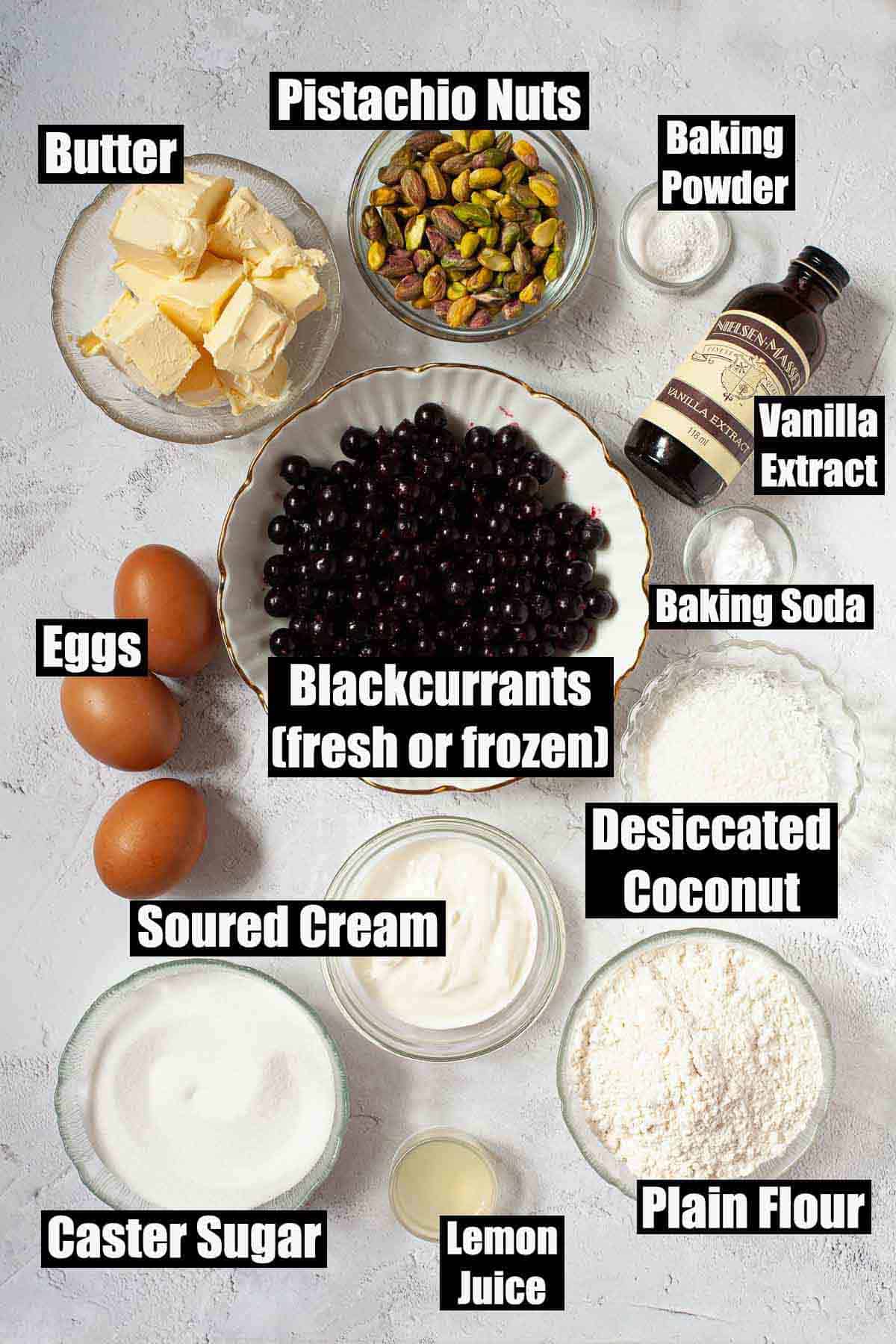
Blackcurrants: You can use fresh or frozen fruit, but it must be at room temperature – not chilled. Using cold or frozen fruit can lengthen cooking time and cause the cake edges to over bake before the centre is cooked through.
For fresh blackcurrants, make sure they’re clean and dry. If using frozen, fully defrost them and bring to them to room temperature before baking.
Ground pistachio nuts: These can be hard to find in stores, but making your own with shelled pistachios is easy if you have an electric coffee grinder or food processor. If not, ground almonds are a great substitute.
Desiccated coconut: This is dried coconut ground down to a relatively fine texture. If you can’t find it, pop some shredded coconut into your food processor and pulse a few times to break it down. Don’t turn it to dust though.
Soured cream: I love using soured cream in sponge cakes for extra moisture and a tender crumb. Plain Greek yogurt works well as a substitute.
Lemon juice: A splash of lemon juice is essential in this blackcurrant cake recipe to preserve the fruit’s vibrant purple colour. Without it, the fruit may turn an unappealing shade of blue so don’t skip it.
Step by step instructions
Full instructions and measurements are given in the printable recipe card at the end of this post.
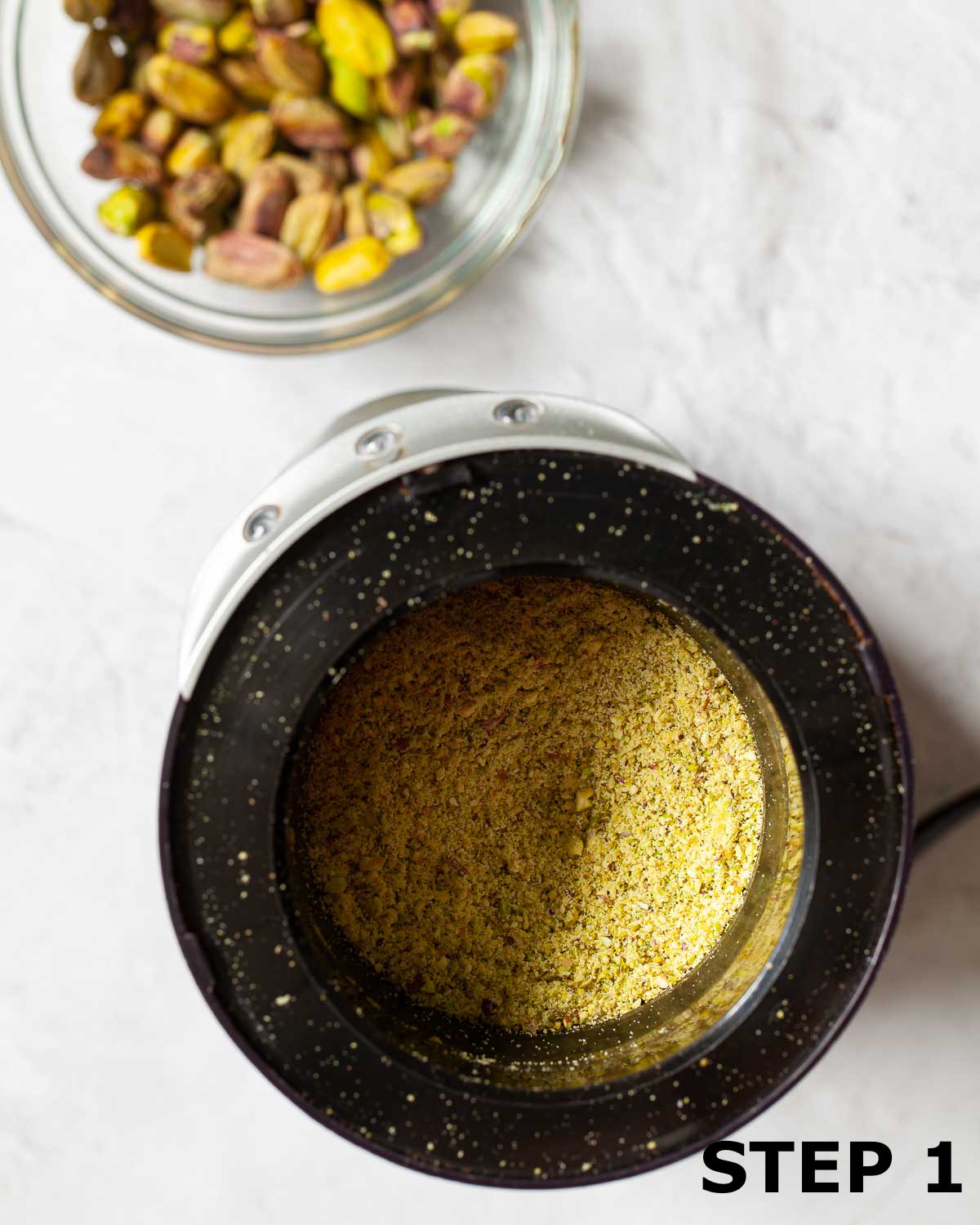
Step 1: Grind the pistachio nuts in an electric coffee grinder or food processor.
Note: it’s best to pulse in short bursts of 2-3 seconds to avoid overprocessing the nuts as this will turn them oily.

Step 2: Cream the butter and sugar together using electric beaters until pale and fluffy.
Add the eggs, one at a time, beating well between each addition.
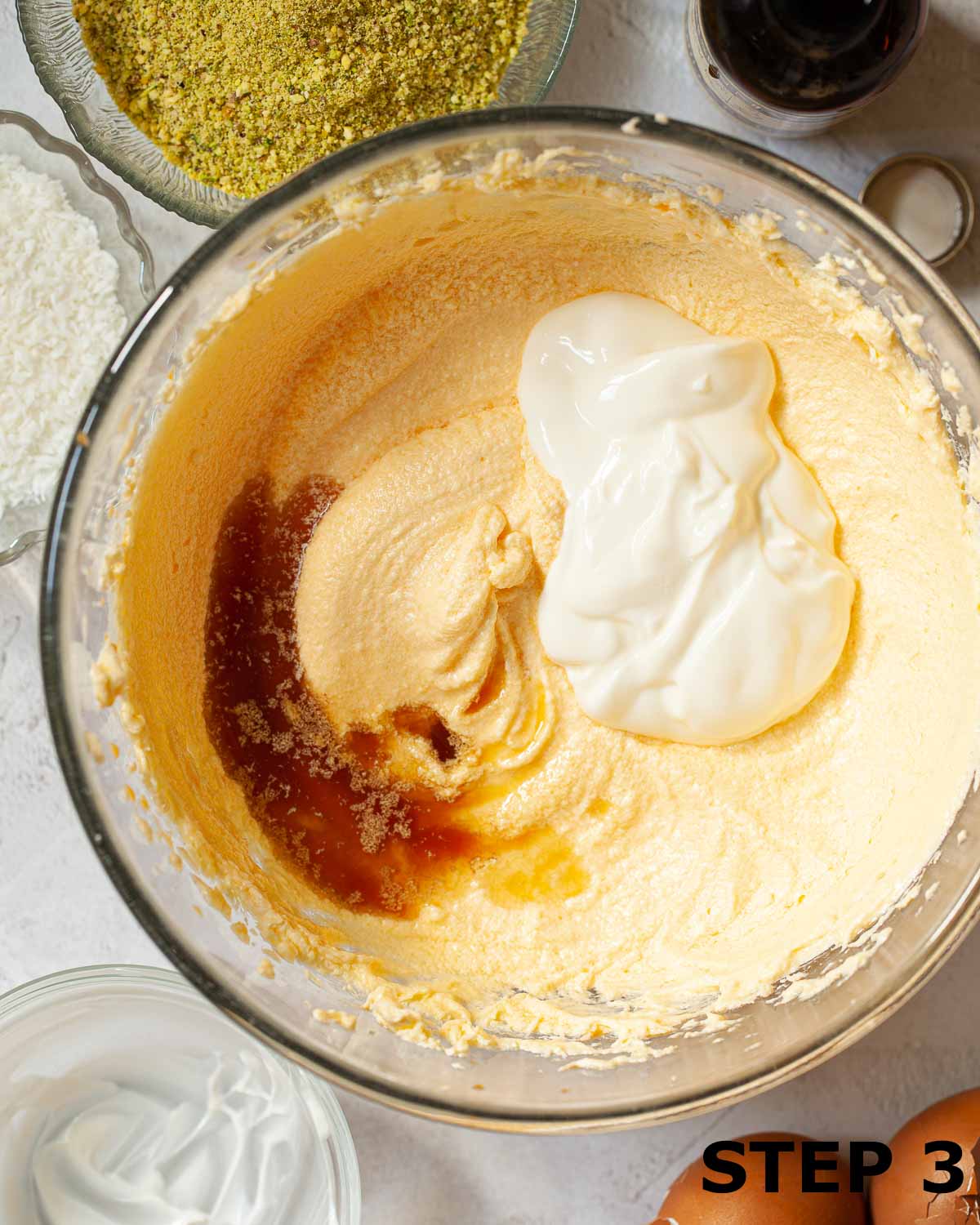
Step 3: Mix in the soured cream and vanilla extract.
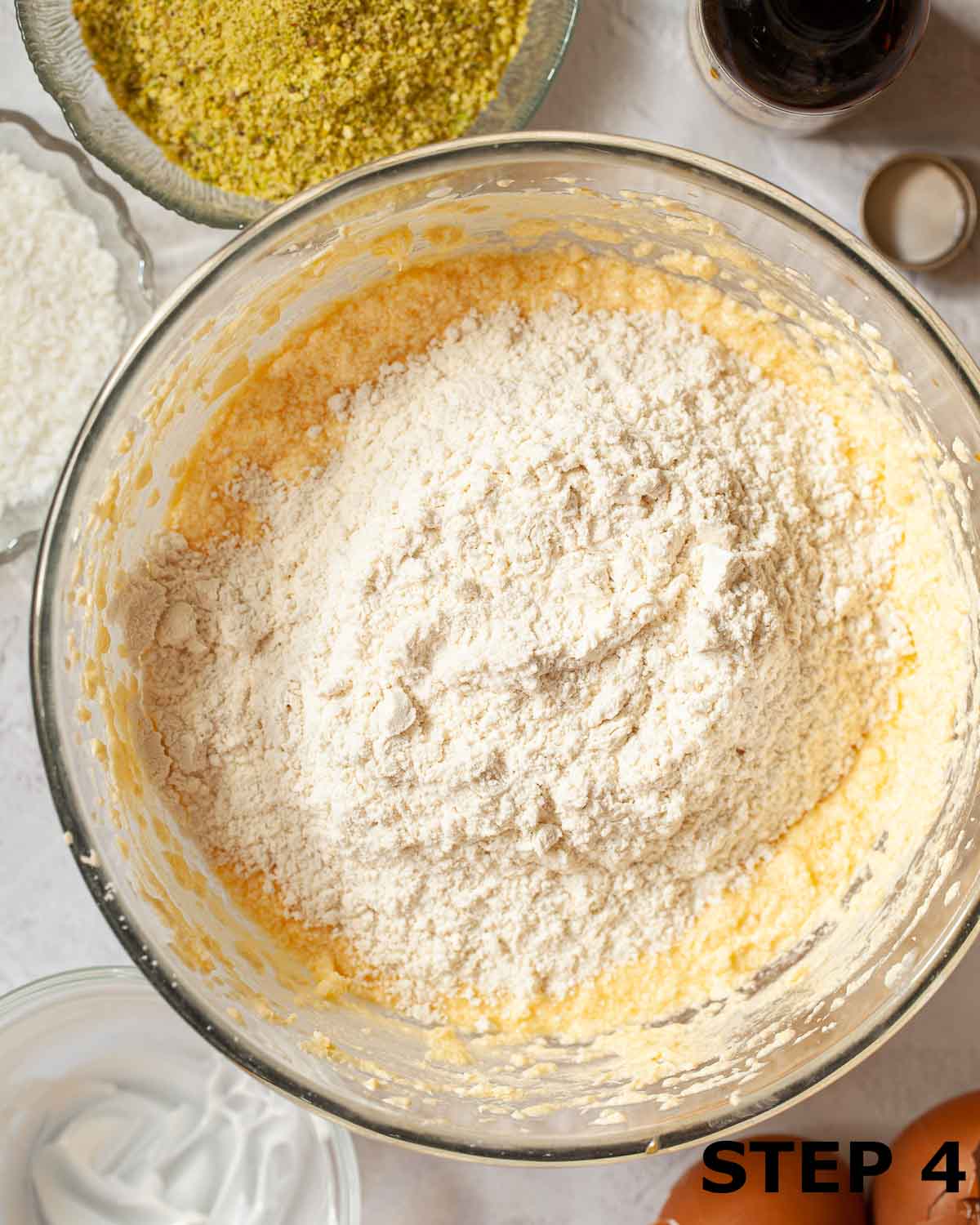
Step 4: Sieve the flour, baking powder and bicarbonate of soda into the bowl and fold in using a metal spoon.
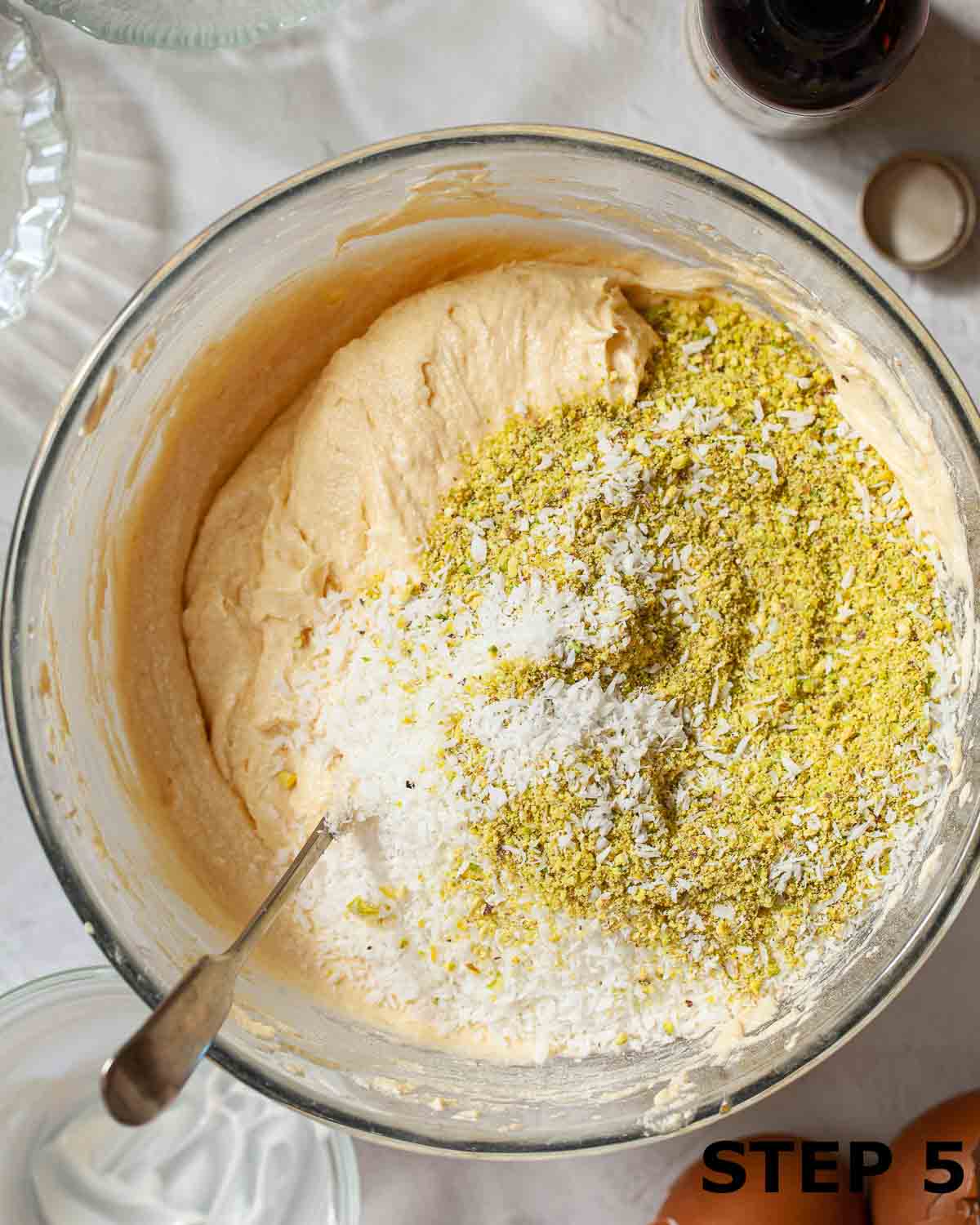
Step 5: Fold the ground pistachio nuts and desiccated coconut in.

Step 6: Toss the blackcurrants in the lemon juice and sugar
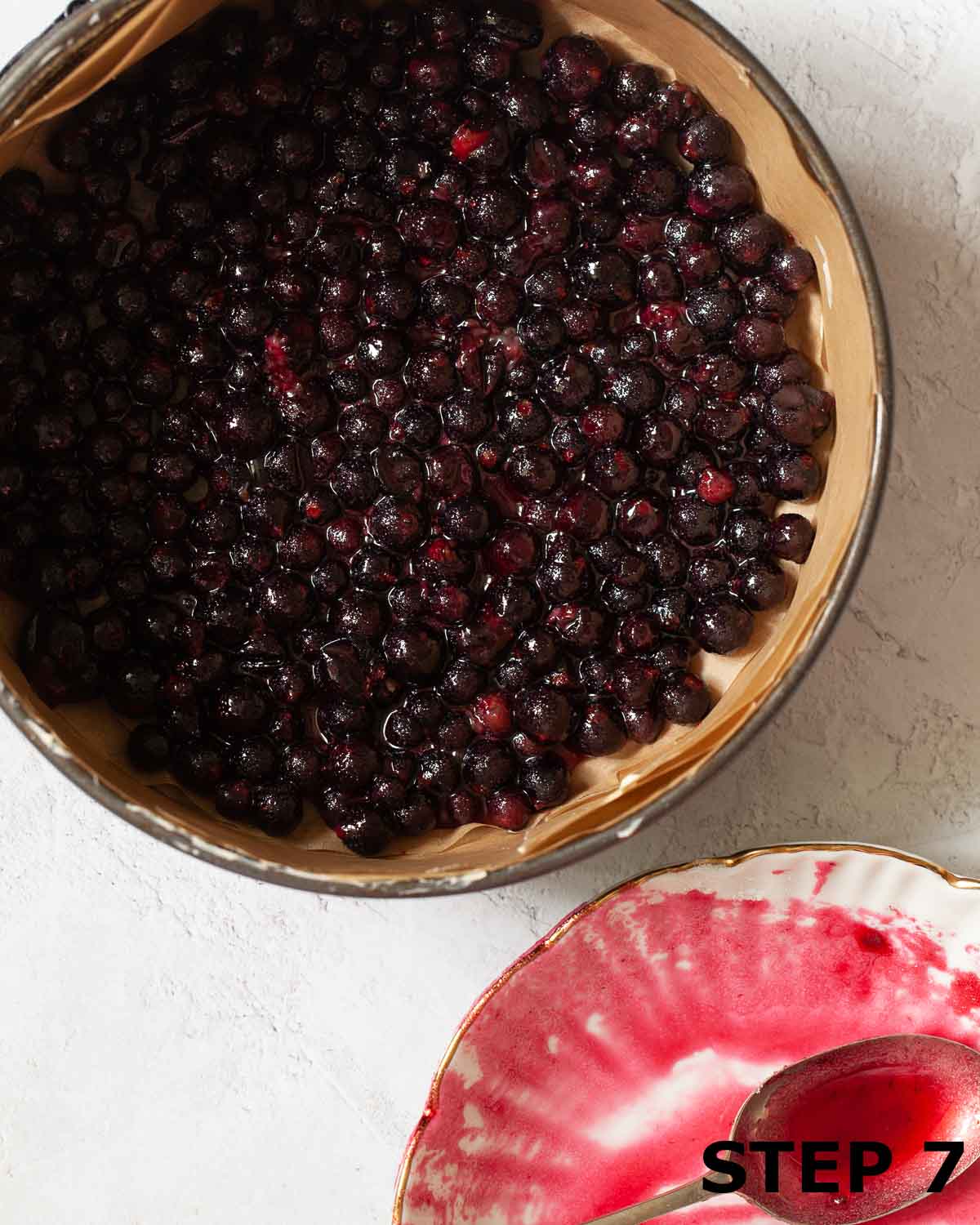
Step 7: Spread the blackcurrants into the base of a greased and lined 8-inch spring-form baking tin.
Note: both the base and side of the baking tin should be lined with baking parchment.
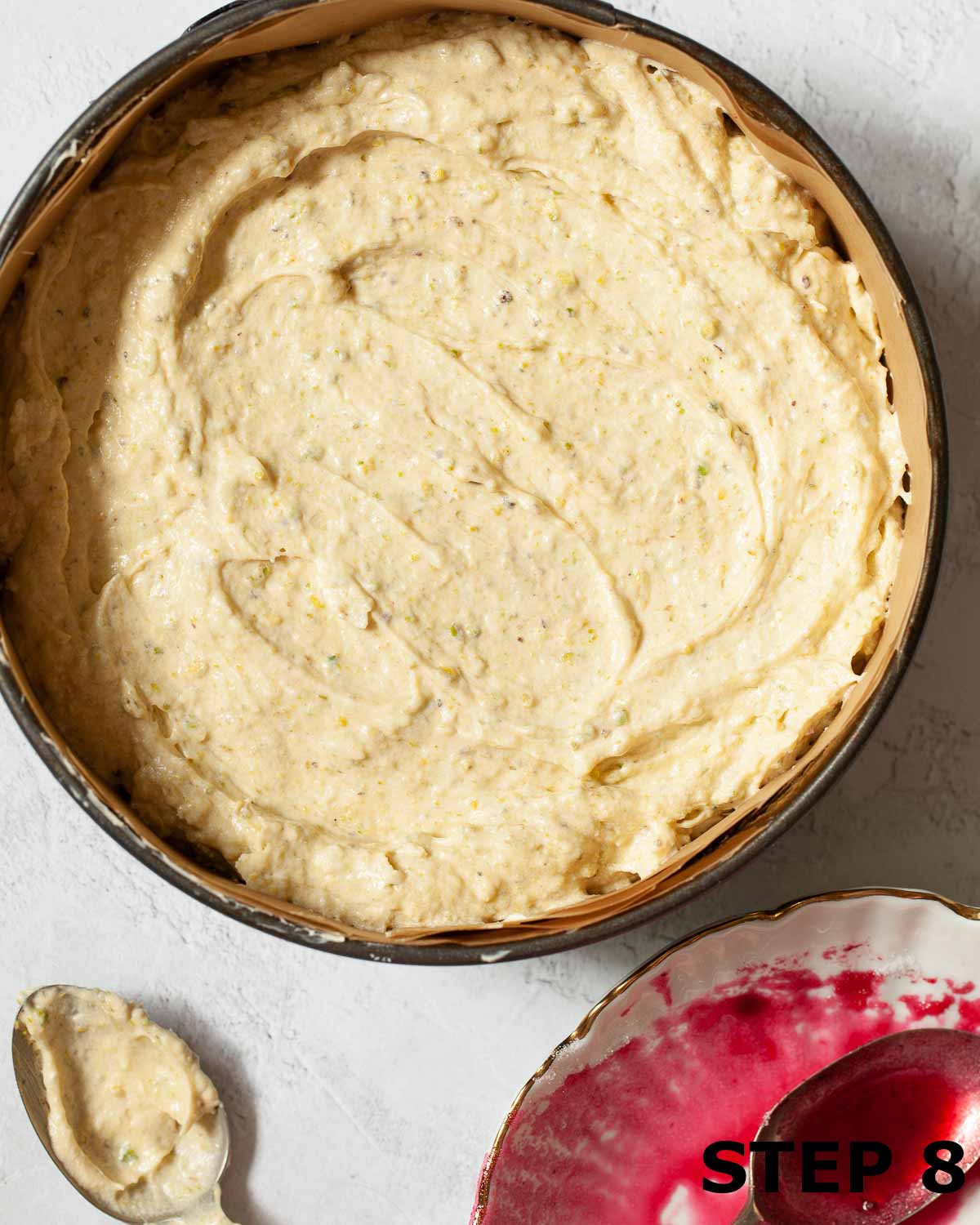
Step 8: Spoon the cake batter over the top, put the cake tin onto a lipped baking sheet (to catch escaped liquid) and bake for 35-40 minutes until a skewer poked into the centre of the cake comes out clean.
Let the cake cool for 10 minutes in the tin then carefully invert onto a cooling rack, unclip the tin and remove. Pull off the baking paper and leave the cake to cool.
Step 9: Let the blackcurrant cake cool for 10 minutes in the tin then carefully invert onto a cooling rack, unclip the tin and remove. Pull off the baking paper and leave the cake to cool.
Expert tips
- Measure accurately. Always use grams and digital scales for precision and better results. Cups are not accurate enough for baking.
- Use the right tin. A deep 8-inch springform cake tin is essential. Smaller tins won’t fit all the batter, and larger ones will affect baking and leave the topping sparse.
- Use a spring-form tin. It’s the easiest tin to use for this blackcurrant cake recipe as it makes getting the cake out so much easier once it is baked.
- Line the tin. Line both the base and sides with parchment. It prevents sticking, makes removing the cake easy and reduces leakage.
- Expect some leaks. Place the tin on a rimmed baking sheet to catch any drips – much easier than cleaning the oven (trust me!).
Frequently asked questions
This cake keeps well for up to 5 days at room temperature in an airtight container.
It also freezes well – open-freeze whole, in slices, or as leftovers. Once solid, wrap in food film and defrost at room temperature before serving.
You can also make this cake with redcurrants or blackberries – both pair beautifully with the pistachio and coconut sponge.
Use 6 tablespoons of sugar for redcurrants (they’re tarter) and 4 tablespoons for blackberries (they’re sweeter).
You can certainly try, but in my experience, they often sink to the bottom – even when tossed in flour first. This is especially true of frozen blackcurrants.
Fresh blackcurrants are in season in the UK towards late June through July. They are not often seen in supermarkets but are common at pick-your-own farms or in farm shops.
Frozen blackcurrants can be found, year-round, in the freezer section of well stocked farm shops.
I do not recommend using ready made blackcurrant pie filling. It will be too sweet and runny to be successful.
If you cannot get fresh or frozen blackcurrants, may the cake without the fruit then spoon some pie filling over each slice at the point of serving instead.
Serving suggestions
- This upside-down blackcurrant cake makes a delicious dessert served warm after cooling for about 45 minutes—pair it with whipped cream, clotted cream (happy sighs), or ice cream.
- Enjoy it at room temperature with a cup of tea. It’s lovely on its own or with whipped cream, clotted cream, or lightly whipped mascarpone on the side.
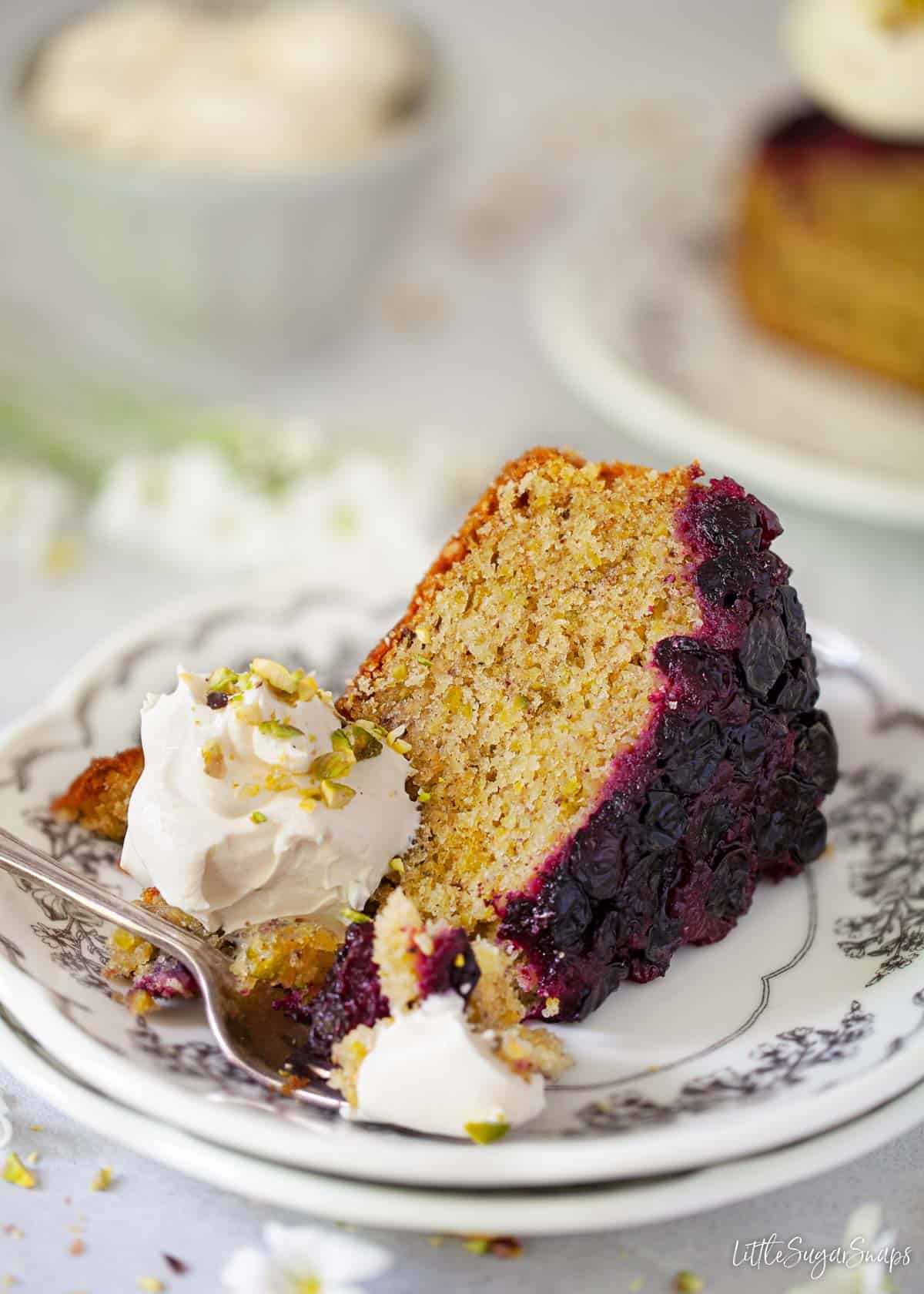
More fruity cake recipes to try
Have you made this blackcurrant cake recipe? Did you serve it cold with tea or warm as a blackcurrant dessert? If you’ve made it please leave a comment and/ or rating below and don’t forget to share your gorgeous creation with me on Instagram (tag #littlesugarsnaps).
New here? Why not sign up to receive LittleSugarSnaps newsletters. You’ll hear first-hand when new recipes are published. You’re welcome to stay in touch on Facebook, Instagram and Pinterest too.
📖 Recipe
Want to Save This Recipe?
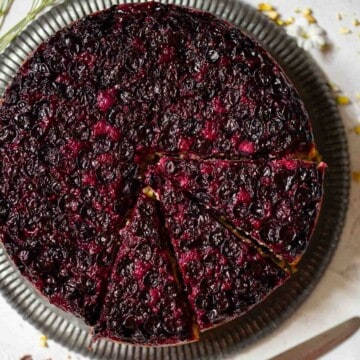
Blackcurrant Cake with Pistachio and Coconut
Equipment
Ingredients
For the blackcurrant layer
- 250 g Blackcurrants fresh or frozen but they must be defrosted and at room temperature.
- 1 tablespoon Lemon juice
- 5 tablespoons Caster sugar
For the sponge cake
- 180 g Butter or baking margarine room temperature
- 180 g Caster sugar
- 3 Eggs large, free-range
- 90 g Soured cream or plain Greek yoghurt
- 1 tablespoon Vanilla extract
- 150 g Plain flour (all-purpose)
- 1½ teaspoons Baking powder
- ½ teaspoon Bicarbonate of soda
- 90 g Ground pistachio nuts can be made from whole pistachio nuts (see notes) or use ground almonds
- 3 tablespoons Desiccated coconut
Instructions
- Preheat the oven to 180C/ 350F/ GM 4 and grease and line a spring-form baking tin with baking parchment (base and sides).
- Grind the pistachio nuts in an electric coffee grinder or food processor (see notes below).
- Cream the butter and sugar together using electric beaters until pale and fluffy.
- Add the eggs, one at a time, beating well between each addition. The mixture may curdle but don't worry about this. When the flour is mixed in the batter will come back together and bake well regardless.
- Mix in the soured cream and vanilla extract.
- Sieve the flour, baking powder and bicarbonate of soda into the bowl and fold in using a metal spoon. keep mixing just until no streaks of flour remain, then stop.
- Fold the ground pistachio nuts and desiccated coconut in. Take care not to overmix the batter as it will activate the gluten in the flour causing the cake texture to turn rubbery.
- In a separate bowl, toss the blackcurrants in the lemon juice and sugar then spread into the base of the prepared tin in a single layer.
- Spoon the cake batter over the top. Put the tin onto a lipped baking sheet (to catch any juices that run out of the pan) and bake in the preheated oven for 35-40 minutes until a skewer poked into the centre of the cake comes out clean.
- Let the cake cool for 15 minutes in the tin then carefully invert onto a cooling rack, unclip the tin and remove. Pull off the baking paper and leave the cake to cool.
Notes
- Measure accurately. I cannot stress enough how important it is to be accurate when measuring cake ingredients. Use grams and a set of digital scales rather than cups. It’s a much more accurate method of weighing ingredients and gives much better results than the cup system.
- Use a spring-form tin. It’s the easiest tin to use for this recipe as it makes getting the cake out so much easier once it is baked.
- Lining the tin is mandatory. It is essential to line both the base and the sides with parchment. This step not only prevents the cake from sticking to the tin and makes getting it out easy, but it also reduces the amount of liquid that escapes from the tin during baking.
- Expect some liquid to escape. It is highly likely that some liquid will escape, so pop the baking tin onto a baking sheet with a lip around the edge to catch the dribbles. It’ll be much easier to clean the baking sheet than the base of your oven (says the voice of unfortunate experience).
- Use the right sized tin. Only a deep 8-inch cake tin will do for this recipe. A smaller tin will not hold all of the cake batter and a larger tin will affect the cooking time, result in a flatter cake and the layer of blackcurrants will look sparse.

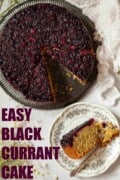
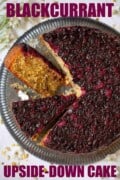
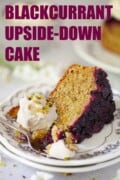
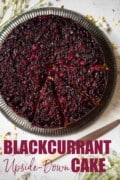
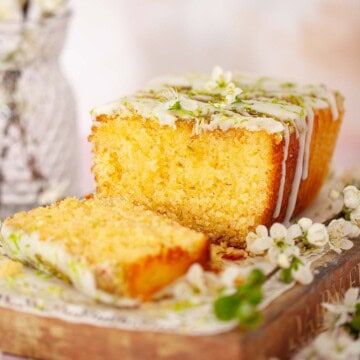
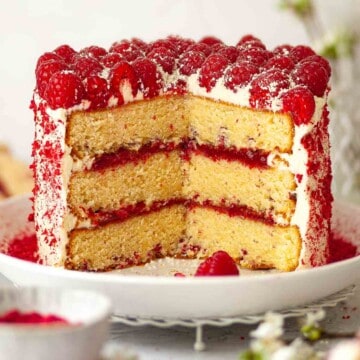
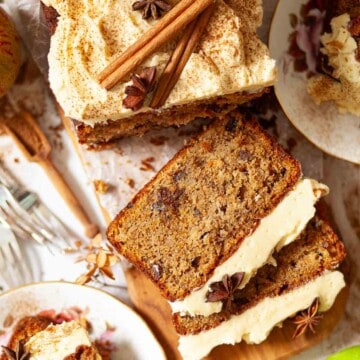
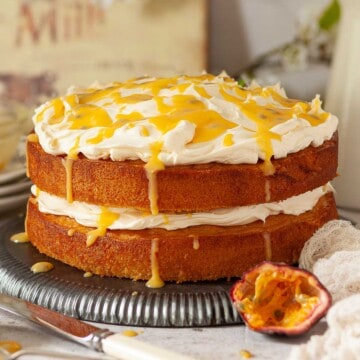

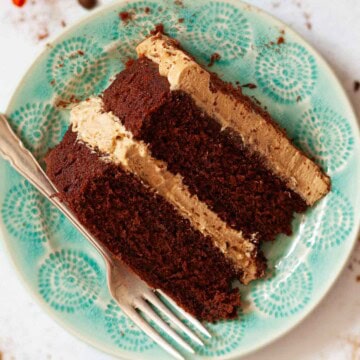
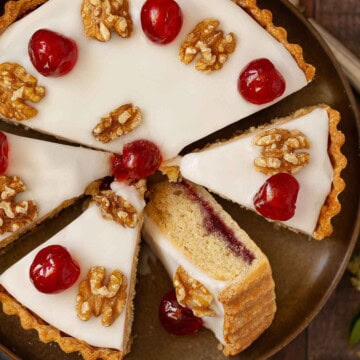

Juanita
This recipe looks amazing! I’m looking forward to baking it! I’m wondering if you have tried splitting the batter into two loaf pans? I’d rather do that, as I plan to give them away as gifts. What would the baking time change to?
Jane Coupland
Thanks Juanita. To be honest, I’ve not tried splitting it into loaf tins. As it’s an upside down cake I’m not convinced it’s entirely suitable and I think that the cakes might end up a little thin with a sparse blackcurrant layer. If you do decide to give it a go use small tins (1lb) and increase all ingredients by 1/3 as much again. Suggest testing if it’s done after 25 mins, but that’s just my best guess rather than a tested bake time.
Deanna
Love this cake. Have made it a number of time my family love it
Tho I find it takes almost an hour to cook
But a beautiful cake severed with whipped cream
Jane Coupland
Hi Deanna – thanks sop much for taking the time to comment and rate this recipe. It’s one of my favourites so I’m pleased you’ve been enjoying it too.